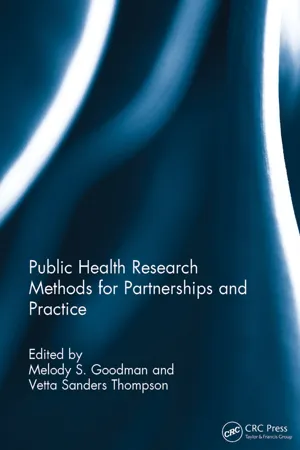
Public Health Research Methods for Partnerships and Practice
- 340 pages
- English
- ePUB (mobile friendly)
- Available on iOS & Android
Public Health Research Methods for Partnerships and Practice
About this book
Translating research into practice involves creating interventions that are relevant to improving the lives of a target population. Community engaged research has emerged as an evidence-based approach to better address the complex issues that affect the health of marginalized populations.
Written by leading community-engaged researchers across disciplines, each chapter covers a different topic with comprehensive guides for start-to-finish planning and execution. The book provides a training curriculum that supports a common vision among stakeholders as well as a survey of methods based on core MPH curriculum. Practical appendices and homework samples can be found online.
Public Health Research Methods for Partnerships and Practice will appeal to researchers and practitioners in community or government sectors interested in conducting community-engaged work.
Frequently asked questions
- Essential is ideal for learners and professionals who enjoy exploring a wide range of subjects. Access the Essential Library with 800,000+ trusted titles and best-sellers across business, personal growth, and the humanities. Includes unlimited reading time and Standard Read Aloud voice.
- Complete: Perfect for advanced learners and researchers needing full, unrestricted access. Unlock 1.4M+ books across hundreds of subjects, including academic and specialized titles. The Complete Plan also includes advanced features like Premium Read Aloud and Research Assistant.
Please note we cannot support devices running on iOS 13 and Android 7 or earlier. Learn more about using the app.
Information
1Community-based participatory research
- Describe history and principles of Community-Based Participatory Research (CBPR) project.
- Critically evaluate participants’ positions within their communities and their potential roles within CBPR projects.
- Describe methods to ensure that CBPR research benefits all partners.
- Share lessons learned from CBPR.
- What is community engagement?
- What two research trends contributed to the development of CBPR?
- What are the principles of CBPR?
- What are the benefits of CBPR?
- In a CBPR project, who determines the health problem to be studied or analyzed?
- What are the key components of a partnership plan?
Introduction
Definitions of community
Table of contents
- Cover
- Half Title Page
- Title Page
- Copyright Page
- Dedication
- Contents
- Acknowledgments
- Contributors
- Introduction
- Chapter 1 Community-based participatory research
- Chapter 2 Health disparities—Understanding how social determinants fuel racial/ethnic health disparities
- Chapter 3 Community health and community-based prevention
- Chapter 4 Introduction to epidemiology
- Chapter 5 Cultural competency
- Chapter 6 Health literacy
- Chapter 7 Evidence-based public health
- Chapter 8 Program planning and evaluation
- Chapter 9 Research methods
- Chapter 10 Quantitative research methods
- Chapter 11 Roles, functions, and examples of qualitative research and methods for social science research
- Chapter 12 Research ethics
- Chapter 13 Health services and health policy research
- Chapter 14 Developing a grant proposal
- Chapter 15 Changing health outcomes through community-driven processesImplications for practice and research
- ConclusionCRFT program implementation and evaluation
- Appendix: Self-assessment answer key
- Index